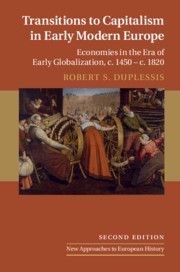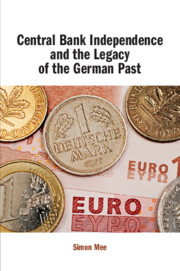Refine search
Actions for selected content:
26946 results in Economic history

Transitions to Capitalism in Early Modern Europe
- Economies in the Era of Early Globalization, c. 1450 – c. 1820
-
- Published online:
- 19 September 2019
- Print publication:
- 26 September 2019

Central Bank Independence and the Legacy of the German Past
-
- Published online:
- 13 September 2019
- Print publication:
- 12 September 2019
Tables
-
- Book:
- Central Bank Independence and the Legacy of the German Past
- Published online:
- 13 September 2019
- Print publication:
- 12 September 2019, pp ix-ix
-
- Chapter
- Export citation
Figures
-
- Book:
- Central Bank Independence and the Legacy of the German Past
- Published online:
- 13 September 2019
- Print publication:
- 12 September 2019, pp viii-viii
-
- Chapter
- Export citation
Copyright page
-
- Book:
- Central Bank Independence and the Legacy of the German Past
- Published online:
- 13 September 2019
- Print publication:
- 12 September 2019, pp iv-iv
-
- Chapter
- Export citation
Abbreviations
-
- Book:
- Central Bank Independence and the Legacy of the German Past
- Published online:
- 13 September 2019
- Print publication:
- 12 September 2019, pp xiii-xiv
-
- Chapter
- Export citation
Dedication
-
- Book:
- Central Bank Independence and the Legacy of the German Past
- Published online:
- 13 September 2019
- Print publication:
- 12 September 2019, pp v-vi
-
- Chapter
- Export citation
2 - The Bank deutscher Länder and the Foundation of West Germany, 1948–1951
-
- Book:
- Central Bank Independence and the Legacy of the German Past
- Published online:
- 13 September 2019
- Print publication:
- 12 September 2019, pp 90-148
-
- Chapter
- Export citation
1 - In Search of the Reichsbank
-
- Book:
- Central Bank Independence and the Legacy of the German Past
- Published online:
- 13 September 2019
- Print publication:
- 12 September 2019, pp 33-89
-
- Chapter
- Export citation
Index
-
- Book:
- Central Bank Independence and the Legacy of the German Past
- Published online:
- 13 September 2019
- Print publication:
- 12 September 2019, pp 346-358
-
- Chapter
- Export citation
Acknowledgements
-
- Book:
- Central Bank Independence and the Legacy of the German Past
- Published online:
- 13 September 2019
- Print publication:
- 12 September 2019, pp x-xii
-
- Chapter
- Export citation
4 - The Shadow of National Socialism: Karl Blessing and the Bundesbank in 1965
-
- Book:
- Central Bank Independence and the Legacy of the German Past
- Published online:
- 13 September 2019
- Print publication:
- 12 September 2019, pp 192-251
-
- Chapter
- Export citation
5 - The Bundesbank, Social Democracy and the Era of the ‘Great Inflation’, 1970–1978
-
- Book:
- Central Bank Independence and the Legacy of the German Past
- Published online:
- 13 September 2019
- Print publication:
- 12 September 2019, pp 252-313
-
- Chapter
- Export citation
Contents
-
- Book:
- Central Bank Independence and the Legacy of the German Past
- Published online:
- 13 September 2019
- Print publication:
- 12 September 2019, pp vii-vii
-
- Chapter
- Export citation
3 - Adenauer’s Challenge: The ‘Gürzenich Affair’ and the Bank deutscher Länder, 1956–1957
-
- Book:
- Central Bank Independence and the Legacy of the German Past
- Published online:
- 13 September 2019
- Print publication:
- 12 September 2019, pp 149-191
-
- Chapter
- Export citation
Bibliography
-
- Book:
- Central Bank Independence and the Legacy of the German Past
- Published online:
- 13 September 2019
- Print publication:
- 12 September 2019, pp 333-345
-
- Chapter
- Export citation
Introduction
-
- Book:
- Central Bank Independence and the Legacy of the German Past
- Published online:
- 13 September 2019
- Print publication:
- 12 September 2019, pp 1-32
-
- Chapter
-
- You have access
- HTML
- Export citation
Conclusion
-
- Book:
- Central Bank Independence and the Legacy of the German Past
- Published online:
- 13 September 2019
- Print publication:
- 12 September 2019, pp 314-332
-
- Chapter
- Export citation
Historical Perspectives on Entrepreneurship and Philanthropy
-
- Journal:
- Business History Review / Volume 93 / Issue 3 / Autumn 2019
- Published online by Cambridge University Press:
- 11 September 2019, pp. 443-471
- Print publication:
- Autumn 2019
-
- Article
- Export citation
Buying Gay: How Physique Entrepreneurs Sparked a Movement. ByDavid K. Johnson. New York: Columbia University Press, 2019. xiv + 308 pp. Photographs, illustrations, notes, index. Cloth, $32.00. ISBN: 978-0-231-18910-1.
-
- Journal:
- Business History Review / Volume 93 / Issue 3 / Autumn 2019
- Published online by Cambridge University Press:
- 11 September 2019, pp. 647-650
- Print publication:
- Autumn 2019
-
- Article
- Export citation
